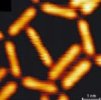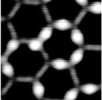Hierarchical Self-Assembly on Surfaces
Hierarchical self-assembly of functional nanostructures on surfaces can be achieved by featuring different degrees of interaction between the molecular and ionic components. Thus, 2D nanopore-array formation by hydrogen bonding or metal coordination sets the base for the nanopore inclusion of additional ligand or the introduction of ellipsoidal macrocycles. On the other side, nanoparticle decoration on top of the π-faces of the involved organic materials can be achieved by sublimation of an additional second metal.



Figure showing the hierarchical inclusion of (left) macrocycles and (middle) dicarbonitrile ligands into self-assembled nanopores. Additionally, the 2D network decoration by Fe-nanoparticles is depicted (right).
